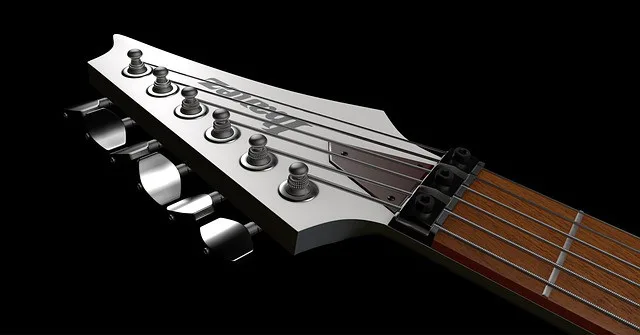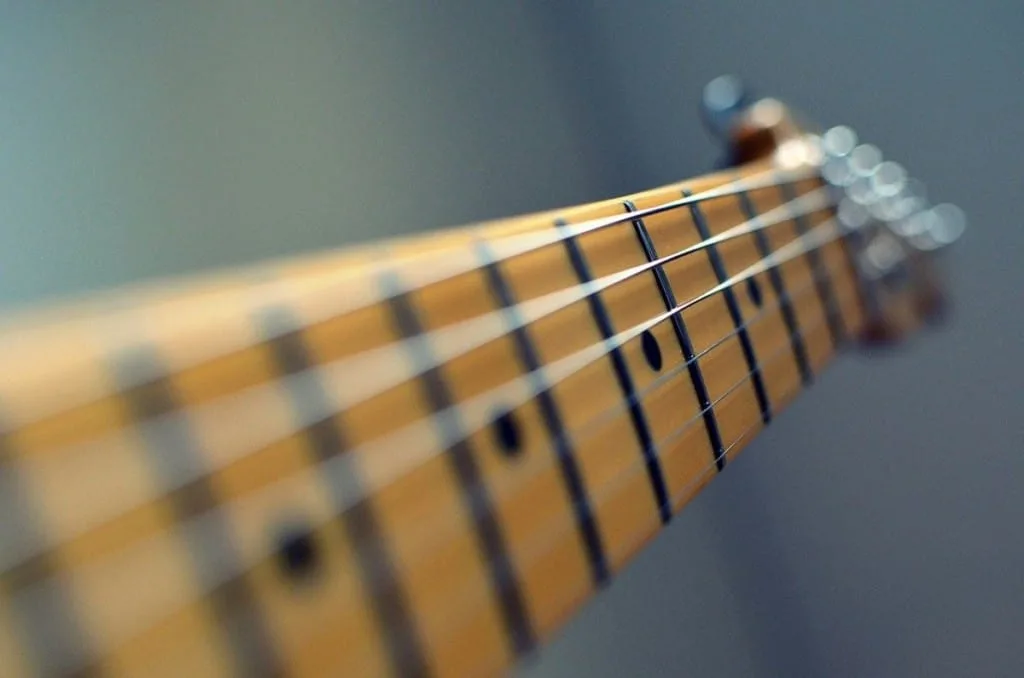You might think asking the question “Is tuning an electric guitar the same as an acoustic” is a little bit of a basic question to search online for an answer for but don’t worry it’s not.
Actually, it’s one of the most frequently asked questions of all time when it comes to starting playing with an electric guitar, so don’t worry you’ve come to the right place.
So, is tuning an electric guitar the same as an acoustic?
An electric guitar can be tuned in exactly the same way as an acoustic guitar and to the exact same notes as an acoustic guitar. The only difference is it’s a little more difficult to hear the notes to be tuned especially if the electric guitar is not plugged into an amplifier.

Let me explain exactly what I mean.
If you play an acoustic guitar then the notes are naturally louder due to the nature of the instrument.
Yes, an acoustic guitar has a big hole in it that produces sound without needing to be plugged in. The same cannot, of course, be said for an electric guitar as it produces very little sound without being connected to an external amplifier.
This, of course, makes the guitar slightly more difficult to tune but the basic process is exactly the same.
Check out this article for the ultimate beginner’s guide to tuning an Electric Guitar.
(And alternative tunings!)
The usual standard guitar tuning for both acoustic and electric guitars, starting from the thickest, lowest-pitched string (the 6th string) at the top of neck is: E – A – D – G – B – E – The highest E string—is the thinnest, highest-pitched string at the bottom of the neck—is known as the 1st string and all others follow on from there from string 1 to string 6, This is exactly the same on both acoustic and electric guitars.
Which Tuner Is Best For An Electric Guitar
Did you know that the best tuner for an electric guitar is one that doesn’t even require your instrument to make a sound?
This is great news as it enables you to be able to tune up an electric guitar anywhere, anytime even in a noisy environment, without even having an external amplifier connected.
The Planet Waves PW-CT-12 NS Micro Headstock Tuner actually works on vibrations from the guitar rather than using actual sound waves to tune the guitar!
It’s so small you can leave it permanently attached to your instrument and it even features an inbuilt metronome for practicing those pesky scales!
A tuner isn’t just an accessory, it’s a necessity. However, there are some accessories you might not be able to live without as a guitar player
I’ve listed 21 of them in this article
Tuning Tips For An Electric Guitar
Getting an electric guitar in tune is essential to producing great chords and instrumental playing.
There are two different ways you can be OUT of tune on an electric guitar. You can either be sharp or flat on each individual string.
If your string is flat that means your note is under pitched or too low.
If your string is sharp that means your note is over pitched or too high.
Using a basic tuner like The Planet Waves PW-CT-12 NS Micro Headstock Tuner will give you a visual reference to tuning, anything to the left on a visual tuner gauge is flat or under pitched and anything to the right on the tuner gauge means sharp or pitched too high.
As a general rule, it is always better to tune a guitar from a flat string (pitched too low) to the correct pitch. This will help maintain the pitch especially when the strings are new as it helps them to not slacken off.
If you are tuning a guitar string from being too sharp (over pitched) to the correct position you may find your guitar struggles to stay in tune.
If you have a different issue than basic guitar tuning, such as a guitar that won’t stay in tune, be sure to check out my article that covers this exact problem here
One tip you can remember is always try to tune UPWARDS. If you find you are already sharp (over pitched) then DE-tune the selected string to slightly under the correct pitch (flat ) and then tune UP to the correct note. This helps take the slack out of the string and helps the tuning process, especially on an electric guitar.
Here’s a basic video on how to get IN TUNE.
Common Guitar Tuning For Various Types Of Guitar
I thought it would be useful to include some basic tunings for various guitar types.
- Standard 6 String Guitar E A D G B E
4 String Bass E A D G
5 String Bass B E A D G
6 String Bass B E A D G C
Avoiding Common Problems When Tuning An Electric Guitar
The less time it takes you to tune a guitar and get it to stay in tune the more time you have to play it, so let’s take a look at some common reasons electric guitars sometimes just won’t stay in tune no matter what you seem to do.
- Tuning Pegs. Did you know you can adjust how resistant the tuning pegs are? I’m not talking about how you tune the actual guitar strings but more about the resistance you feel when turning each tuning peg. This resistance can be altered on many electric guitars using a small flat or cross headed screwdriver. If the pegs are unevenly adjusted in relation to each other you can have problems keeping your guitar in tune.
- Intonation throughout an electric guitar. If your guitar isn’t in tune with its self, then it will never be in tune with anything else. One thing to take note of on an electric guitar compared with an acoustic is how the actual strings feel when you hold them down to play. If your strings feel too stiff to press down it’s because they are adjusted too high in relation to the fretboard/neck. If the strings are lower than they should be you will hear rattling and vibration noises.
- The way to adjust the height of the strings (not the length) is to adjust the bridge of the guitar as a whole unit or by adjusting the height of the individual string saddles on the bridge. You can turn the individual string saddles clockwise to lift the string higher (away from the fret-board) or anti-clockwise to move it lower.
- It is also essential that you have an accurate tuning device such as the Planet Waves PW-CT-12 NS Micro Headstock Tuner to help you check all these adjustments along the way. Be sure to take a look at this product as it’s an essential tool to have.
- In fact, take a look at my article on the best 21 guitar accessories you need and why. You can view this helpful article here
- For more in-depth tips on keeping your guitar in tune over a longer period of time check out my more advanced article here
Here’s a video explaining exactly what I mean. It’s described in really simple terms so anyone can understand it.
- One great tip from this video is that you should always make sure your open strings are in tune before adjusting the saddles to correct any intonation issues.
Final Thoughts
If you are new to the electric guitar or just starting out on your playing journey try not to get too overwhelmed with too much in-depth information to start with.
Try to make sure that you have each individual string on its own in tune before you attempt anything more complex, this will go a long way to helping you with any other issues along the way.
Another tip is to make sure you are using good quality strings from a respected brand such as D’Addario and to make sure your strings are not slipping, You will need to give them a good stretch when first adjusted from new and allow them to settle down for a short while and re-tune.
Never be afraid to ask a simple question in your local guitar shop, they should be only happy to help and If they are not I strongly suggest you shop somewhere else. There are some items that are going to be absolutely essential to you as a guitar player.
I’ve listed 21 of the most essential guitar accessories in another article, Take a look here to find out exactly what they are, and why you need them.

Don’t forget everyone had to start at the beginning!
Once you have your guitar in tune be sure to read through my article that explains some secret sauce on making sure it stays in tune.
Be sure to check out that article here
I hope this helps you along your path to learning and enjoying the experience of owning and playing an electric guitar.
Happy Playing
